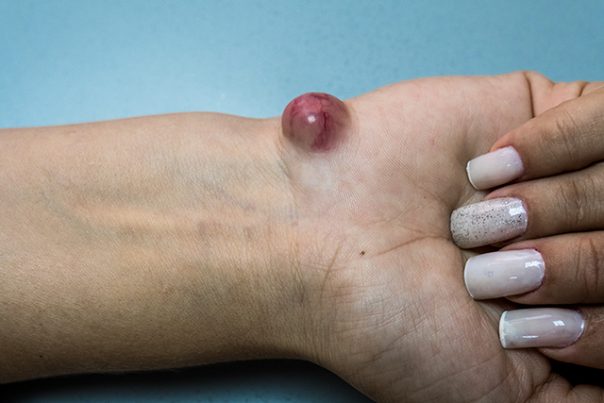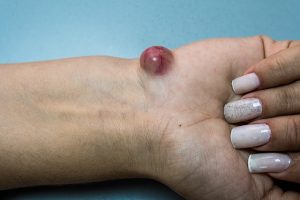
Ganglion cysts – causes, side effects and treatments at NaturalPedia.com
Wednesday, March 28, 2018 by Ralph Flores
http://www.naturalpedia.com/ganglion-cysts-causes-side-effects-and-treatments-at-naturalpedia-com.html

A ganglion cyst is defined as a fluid-filled swelling that can often be found near a joint or a tendon. While a ganglion cyst can be located in any joint, it is most common on the wrist and, at times, the hand and fingers.
Physically, it looks and feels like a smooth lump under the skin. The fluid inside the cyst is a thick, sticky, clear, colorless, jelly-like material. Ganglion cysts are benign, and these are common as well: It accounts for nearly half of all soft-tissue tumors of the hand.
The etiology of a ganglion cyst is unknown. Some believe that it is caused by a previous injury which caused joint tissues to break down into small cysts, while others think that it is due to a defect in the joint capsule or tendon. However, it may also form when the joints and tendons become irritated.
In most cases, ganglion cysts are not painful. However, if they press on a nerve, then pain or even muscle weakness can be felt. Depending on the location, they can also interfere with joint movement.

Known risk factors and symptoms of ganglion cysts
Anyone can have a ganglion cyst in their lifetime, but some risk factors increase its likelihood.
- Sex and age — The cysts are common in women between 20 to 40 years.
- Osteoarthritis — People who currently have osteoarthritis are even more prone to ganglion cysts, especially those with wear-and-tear arthritis.
- Previous injury — Those with previous injuries, in particular, in joints or tendons, are more likely to develop the condition.
The hallmark symptom of a ganglion cyst is a visible lump near the joint. However, there are also cases of occult ganglions, ones that are hidden under the skin. There are no symptoms beyond the appearance of the cyst, but if it puts pressure on the nerve passing through the joint, it may also cause pain, tingling, or even muscle weakness.
Body systems affected by ganglion cysts
Ganglion cysts are localized and only occur in the joints – in particular, the backside of the wrist. While their appearance may be a cause for concern, they are non-cancerous formations.
Food items or nutrients that may prevent or relieve ganglion cysts
A ganglion cyst can be treated by simple medication and home treatments in most cases. To reduce the discomfort caused by the cyst and promote circulation and fluid drainage, apply a warm compress on the affected area for five to ten minutes. Alternatively, used black tea bags also provide anti-inflammatory effects and alleviate the discomfort and swelling when applied to the cyst.
Turmeric is also beneficial for attenuating the pain and discomfort caused by ganglion cysts, as well as reduce the inflammation.
Treatment and management options for ganglion cysts
The first line of treatment for ganglion cysts is to observe it, as most cysts may disappear without the need for medical intervention. In the event that it causes pain because of activity, a wrist or a splint may relieve the symptoms.
Other methods involve aspiration or the drainage of fluid from the cyst; however, this may not effectively eliminate it as the “root” or the connection to the tendon is not removed. In cases of recurring ganglion cysts, surgery may be recommended, but there is still a small chance that the cyst may return.
Where to learn more
- Combination Of These 2 Ingredients Kills Cysts And Fibroids Naturally
- Suffering From Cancer, Thyroid Disease, Chronic Fatigue, Cysts, or Weight Problems? Think Iodine Deficiency
- Grapefruit naturally prevents formation of kidney cysts
- 7 Home Remedies to Get Rid of Cysts & Fibroids Naturally
- Surprising Chronic Pain Triggers And 7 Natural Painkillers To Cure It
Summary
A ganglion cyst is defined as a fluid-filled swelling often found near a joint or a tendon. It looks and feels like a smooth lump under the skin. In most cases, the cyst is not painful. However, if it presses on a nerve, then pain or even muscle weakness can be felt. Depending on the location, it can also interfere with joint movement. While their appearance may be a cause for concern, they are non-cancerous formations.
Sources include:
Tagged Under: Tags: ganglion cysts





